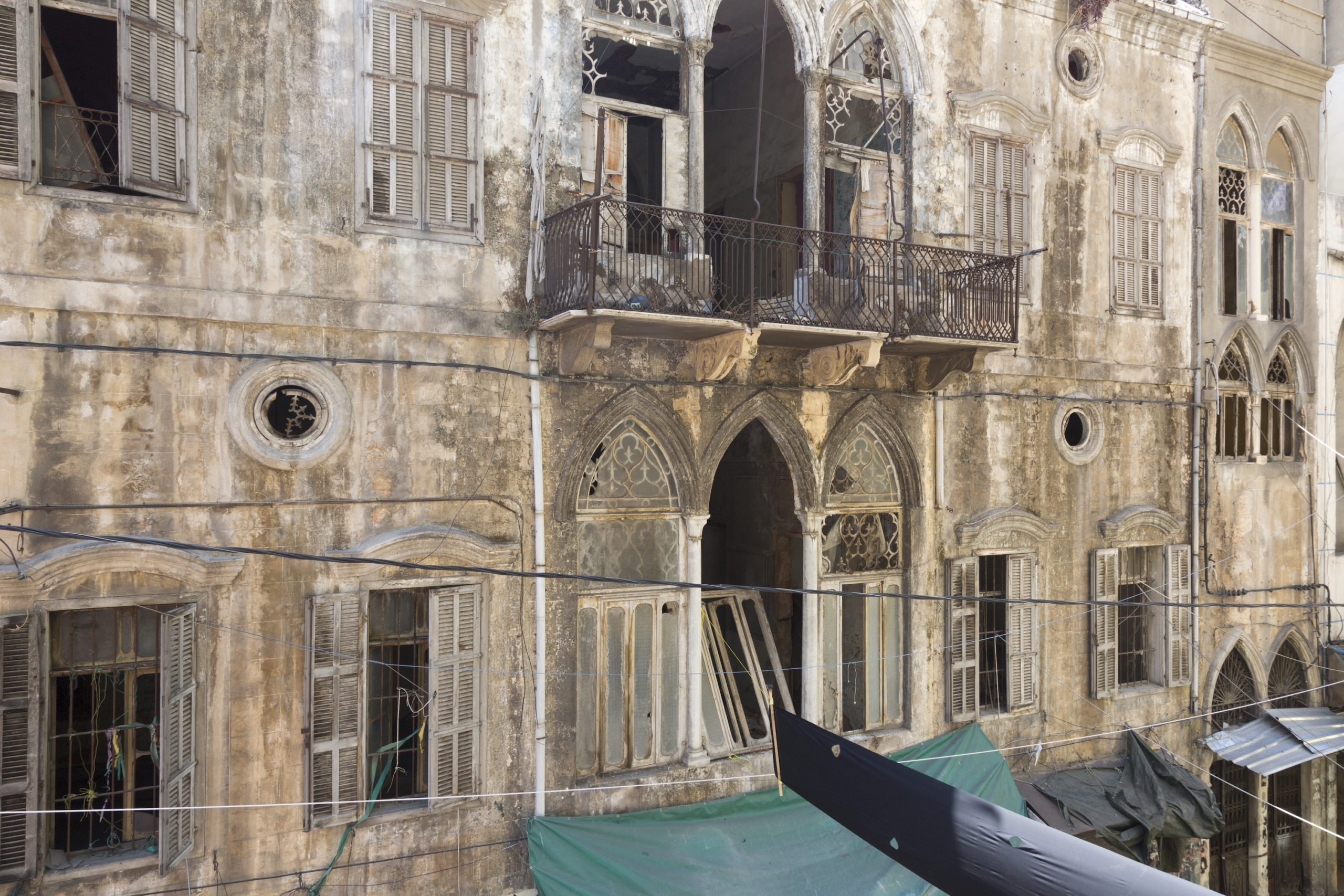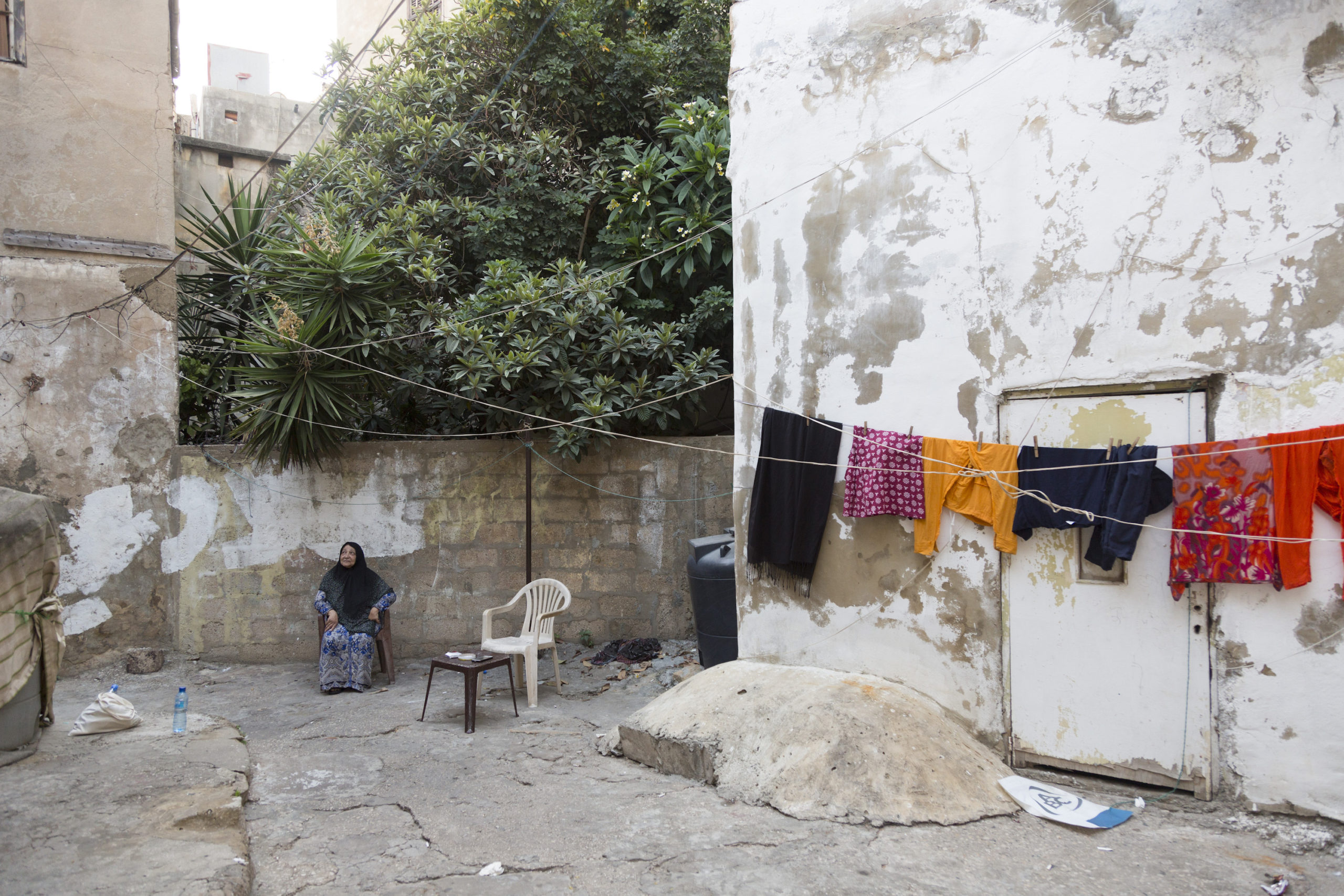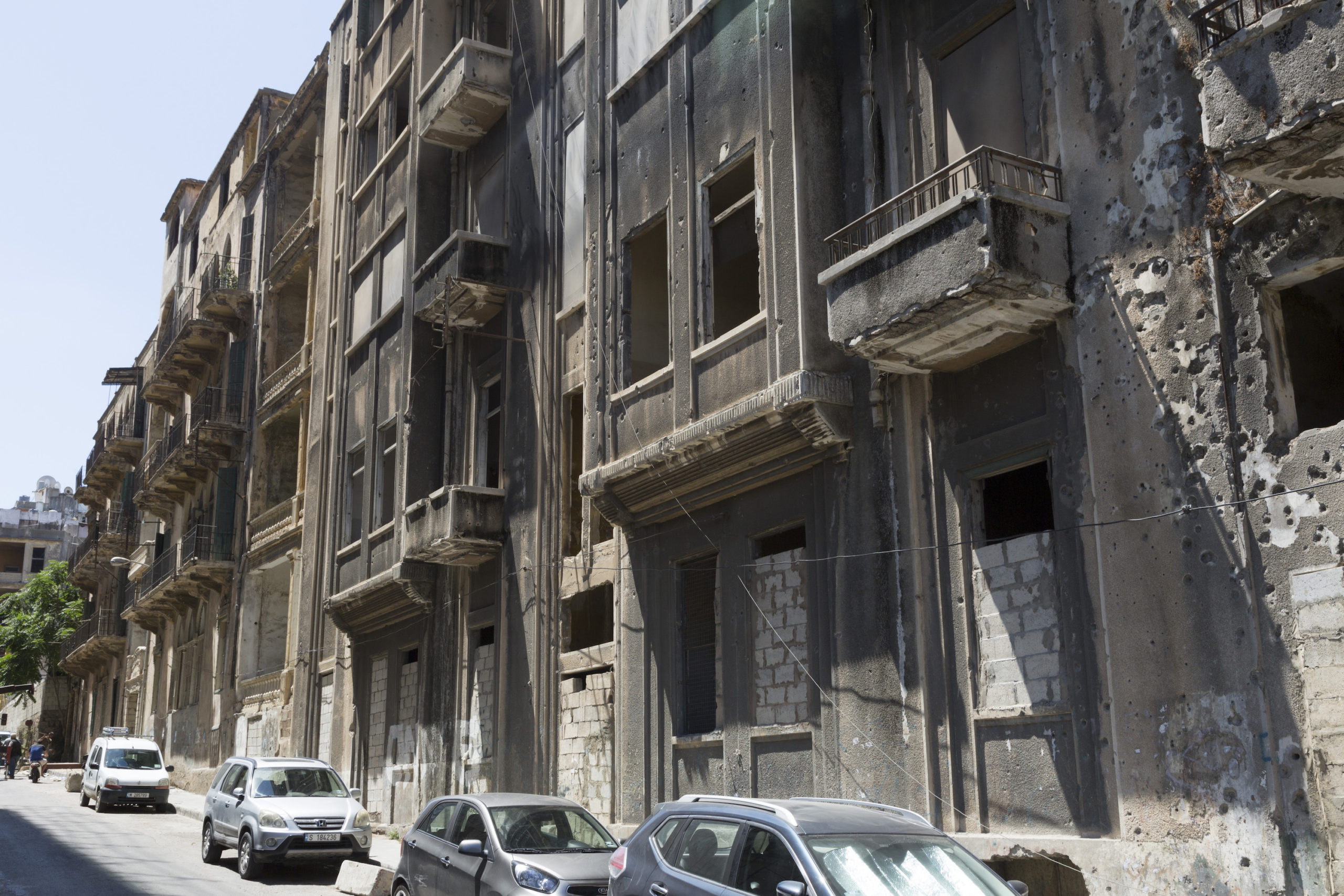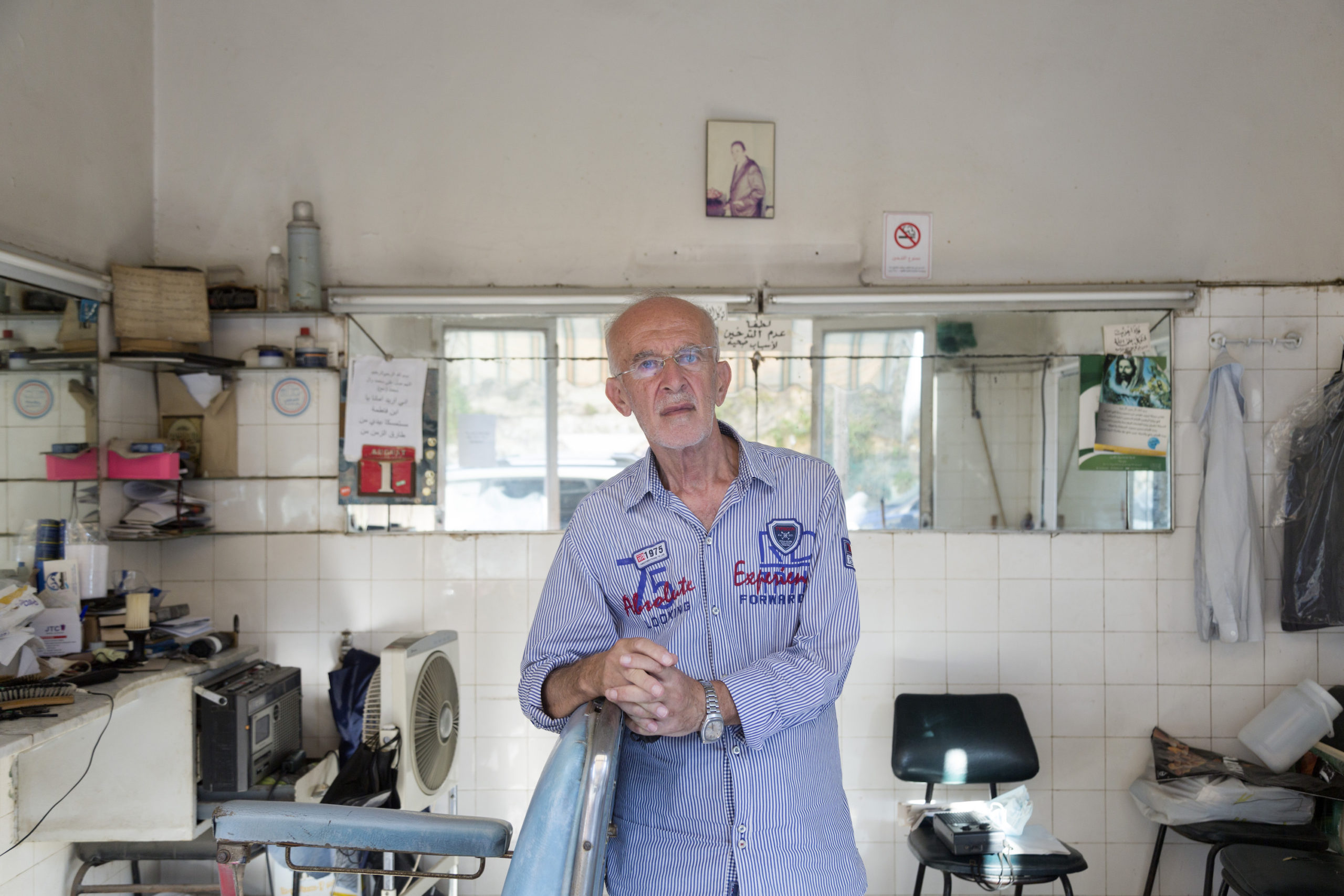A walking archeology of Khandaq al Ghamiq

The district of Khandaq al Ghamiq in Beirut, a five-minute walk from the city centre and about fifteen minutes from the port, bears witness to a historical and architectural heritage that has been relatively untouched by the bulldozers of reconstruction, but is decaying due to neglect.
After the August 4, 2020, Beirut explosion, I would find myself walking and looking for alleys I once visited, houses I once stopped to admire or markets and neighbourhoods I would find solace in. On one of my recent walks, I went to Khandaq al Ghamiq in the neighbourhood of Bachoura, a five minutes’ walk from downtown and some fifteen minutes from the port. Bachoura, like many other neighbourhoods in Beirut, is testimony to the struggle of various urban fragments to preserve their origins and withstand the city’s violent shifts and transformations. The slow growth and development of Khandaq al Ghamiq contrasts greatly with the reconstructed downtown: here, in contrast to the clean-swept city centre, the alleys and culs-de-sac feature choking trees, gutted houses, stone walls being eaten up by weeds and many deteriorating ornamented buildings, most of which continue to be inhabited.
The secret garden
On the day of my walk, wherever I turned, I would see damaged facades and broken windows, and hear the screeching of broken glass being swept up. For a moment of shade and silence I decided to head towards the deserted St. Georges Church, a beautiful Syriac Catholic church built in 1878, now standing choked in between the new Beirut Digital District high risers on the outskirts of Khandaq al Ghamiq. Had I not known that it was there I would never have seen it. While trying to search for someone to help me enter the boarded up remains of the abandoned church, I met Dounia.
I had walked into a dead-end between two crumbling stone houses, at the end of which lay a locked red gate. A neighbour sitting on a nearby balcony had seen me and called out for me to come visit. I was reluctant at first, so she called for Dounia – a 50-year-old strong looking woman – who came walking out of her shop. She unlocked the red gate, ushered me into her house and sat me down in a courtyard squeezed in among the decaying magical fabric of what obviously used to be a bourgeoisie neighbourhood. At once, the city noise seemed to disappear. Two trees, one orange and one mulberry, gave a moment of shade.
Dounia’s home was a one level house with white walls, wooden windows and a newly added red tiled pitched roof. The kitchen was attached to the outside of the otherwise perfectly square building; the trees grew low and wide, creating a complete disconnect with the rest of the city. The family had moved there from South Lebanon in 1958, renting the house from a relative. Since then, they remained, never leaving the city during the various conflicts and wars it witnessed.
Soon after I sat down, Dounia began showing her windows that got damaged in the blast. She introduced me to her mother, who was lying on a couch inside. As we sat talking, they told me the story of how they both survived that day – “a miracle” they kept on repeating. Yet another version of the heart-wrenching tale that so many Beirut residents share.
The trench
Khandaq al Ghamiq literally translates to “deep trench” or “ditch”, and is often referred to simply as Khandaq, “the trench”. There are many tales about the origins of the name, including from the French mandate era when youth in the area were involved in skirmishes with the French soldiers, or the start of the 1958 revolution challenging the rule of president Camille Chamoun (in particular his pro-western outlook). Pro-Nasserist journalist Nassib Matni, editor of the Telegraph newspaper, was assassinated in the vicinity as well. Other stories depict the neighbourhood as eternally set to be a cut-off fragment from its surroundings – perhaps because it was built at a low geographic point in between the two hills of the capital, Ashrafieh and Msaytbeh, and flanked by an impermeable graveyard on its western edge.

The graveyard
The Bachoura cemetery on the outskirts of Khandaq al Ghamiq has high walls made of sandstone, a material used mostly in the late nineteenth century across Lebanon. The walls may have been built as early as 1892, and were then restored after the First World War. There is conflicting information about the age of the graveyard itself, with some texts tracing it back to 1878 and others claiming that Imam Ouzai visited the graves there in the eight century. Still other sources date it back to the time of Caliph Omar Ibn Khattab, who ruled in the seventh century.
One does not walk alongside the graves but, effectively, below them
Historically, the location of cemeteries and placement of the dead have always been significant. Rituals of commemoration and spiritual practices gave rise to stories of miracles, ghosts or other activities that connect the living and the dead. In Khandaq al Ghamiq, the burial place is elevated several meters above the street. One does not walk alongside the graves but, effectively, below them. I wondered out loud if this is what gave the street, and more recently the neighbourhood, its name. But Dounia laughed it off and said that she forgets that the graveyard even exists, as she rarely sees it from her home. The monumental walls give an aura of serenity to the neighbourhood, which seems to survive uncomfortably in the dense urban fabric of Beirut.
As I passed by the cemetery, a man sat in the shade of the wall on the sidewalk. Hadi, who was seated on a plastic chair, smiled and said that he sits here daily waiting for others to join him in their free time. Ten months ago, he was laid off from the printing press he used to work in, and for the first time in his life has time to just sit and watch people pass by. But at 65, with the economic crisis and no retirement plan, he is not without worries for the future. Inside the graveyard, Hadi said, are fountains, some of which are still active and in use. If you dig a few metres into the ground, you will find the old water channels of the neighbourhood. These were of use when Beirut was still confined to its medieval walls in the 1840s, with seven gates and a souk surrounded by agricultural plots. At that time its various graveyards were located on the outskirts, not embedded in the city like today.
Many of the passages that run through the neighbourhood were built on ditches originally used for irrigation
The wall
It was during the same time, in the mid-1800s, that Beirut underwent a major transformation in its modern history. Even though the harbour had placed the coastal city on the map as early as the eighteenth century, it was now that an Ottoman bank, a major harbour and a road connecting Beirut to Damascus and the Middle Eastern interior were constructed. This era also brought various populations to the city, a result of conflicts and upheavals in Aleppo, Damascus, the Beqaa Valley and Mount Lebanon. The incoming migration generated a consequent construction boom: by 1860, some 20,000 merchants and skilled artisans had settled in the city and contributed to its economic growth. Later on, more migrants arrived from the countryside in search of employment opportunities at the port, the markets and the agricultural land surrounding the downtown area. Two decades later, the city had expanded rapidly beyond its disappearing walls and gates.
At this time, the agricultural lands around the old city were transformed into an extension of the city’s fabric. What today is Khandaq al Ghamiq was filled with triple arched villas and workers’ houses, alongside productive agricultural fields and trees. Many of the passages that run through the neighbourhood were built on ditches originally used for irrigation. Perhaps, I wondered, this could be the reason for its name.

Mutations
At the end of the First World War, when the Ottoman Empire collapsed and got divided among the victorious states, Beirut became part of French-ruled Greater Lebanon. Refugees arrived from what is today Armenia, Syria and Turkey (mostly Christians fleeing Ottoman and later Turkish rule), adding to the rural Lebanese families coming to Beirut in search of job opportunities and security. Many came to settle in Khandaq al Ghamiq.
The triple arched villas from the previous century were enlarged vertically to accommodate the density of the area
The newcomers worked at the port or in the souks, markets, in downtown Beirut, which were easily accessible from the area. Khandaq al Ghamiq’s Tayyan Street was connected directly to the networks of sprawling streets and alleys near the sea, and described as a smooth walk down in the mornings. The triple arched villas from the previous century were enlarged vertically to accommodate the density of the area.
Sitting outside the cemetery walls, Hadi said that this period was the golden age of the neighbourhood. A lot of street names also changed between the 1920s and 1940s, a clear tendency to assert an identity by the residents. Umayyad Street became Khandaq al Ghamiq Street well after most water channels had already disappeared.
In addition to a network of villas, buildings and passages connecting the neighbourhood, Khandaq al Ghamiq was linked together by dense alleys, created when the small adjacent rooms surrounding its farmland and gardens were transformed to house the increasing number of workers coming from rural areas. This created a unique mixed community of residents in the neighbourhood. The workers’ buildings typology in the peripheries continued to flourish well into the 1950s, creating a mixed use and income neighbourhood that is still evident in the fabric of Khandaq al Ghamiq.
More transformations
Yet another demographic shift came with the beginning of Lebanon’s 1958 conflict. With so many different communities in a dense neighbourhood, Khandaq al Ghamiq became one of the main battlefields of the conflict. Church-going communities moved out; extended families of people who had come from southern Lebanon moved in. Elsewhere in Lebanon, other migratory routes took place. Various urban growth strategies were also put in place from 1955 to 1965, including the making of three expressways that detached Khandaq al Ghamiq from other neighbourhoods. The decade made room for the construction of government buildings in the area’s vicinity, which brought an even larger demographic shift than before and more demand for housing and office spaces.

In one of the few surviving workers alleys – a two metres wide passage that is reachable only by foot – lives Ibtissam, a woman in her seventies. As I passed by the small neighbouring houses built between 1840 and the 1950s, many surrounding a courtyard with a few surviving trees, I saw her seated outside a series of houses owned by her grandparents, now rented as rooms to low-income workers coming from abroad. “What can we do to change the situation?” she asks as I sit down to talk to her, commenting on the large-looming crisis. Ibtissam has diabetes; just like many others across the country, she has been unable to find her medicine for several weeks.
Preservation
Dounia, the shop owner, also had a house that seemed to belong to the workers’ housing typology, even though neither Dounia nor her mother knows when it was built. Dounia’s mother said that, when they moved in, the house was already old. The courtyards at the time, they said, were filled with trees and small scattered single level rooms put up in the fields, to house the thousands of rural workers that came to settle in the city.
One would think that heritage buildings should be protected, but all houses listed as heritage have been deserted and are falling apart
“This house constantly requires a lot of maintenance,” Dounia said, laughing at the question if it is listed as a heritage building in the area. Beirut’s heritage has been severely threatened by decisions made by various governments since the civil war: many listed buildings have been declassified and neighbourhoods left to deteriorate without preservation. “One would think that heritage buildings should be protected, but all houses listed as heritage have been deserted and are falling apart,” Dounia said. At least she and her mum try to preserve their house by living in it instead of leaving it to decay, allowing for the landlord to find an excuse to come and demolish it.
Heritage protection in Beirut has mainly focused on the triple arched central hall villas that appeared in the 1800s to house high income residents and the first immigrants to the city, some of which may be found on the northern edges of Khandaq al Ghamiq. They were clearly crafted with a lot more ornament and detail than Dounia’s and Ibtissam’s houses. A few remain listed as protected buildings but most are deserted and crumbling, a fate not unknown to buildings all across the city.
In the shade of these houses and trees I met Ali and Abbas, two nineteen-year-olds who presented themselves as members of a powerful political party. The neighbourhood, Abbas said, is indeed a “trench” and therefore has to continue resisting and occupying the space it has in the city. At night, Ali said, they hang out in the streets, because with the constant electricity cuts happening due to the crisis, it is unbearable inside.
I asked them about the courtyard and trees. “I study medicine and am not really interested in the landscape,” Ali said – but the question made him spot trees and branches everywhere: caught behind posters and peeking out from underneath signboards, hanging low over political and religious slogans scribbled on the walls. “Your grandmother used to use these trees when she wanted to give someone a location in the neighbourhood,” said Ali’s mother Khadeeja, who looked out from her grocery shop in the street. As I continued searching for trees, Ali and Abbas went to play pool in a nearby coffee shop.

Abandonment
With the start of the civil war in 1975 and the division of Beirut into east and west along sectarian divides, urban development slowed down. Khandaq al Ghamiq found itself right on the so-called green line separating the city, and literally became a trench. The conflict brought a massive arrival of refugees, mostly from the south of Lebanon, who were distributed in vacant apartments in Beirut. While many of the buildings these displaced families came to inhabit were intact, others had been damaged by mortars and shrapnel shells. Most traces of the socio-economic diversity of the neighbourhood dissipated, as happened with many areas in the city.
With the end of the war, the displaced were supposed to leave the city and return home. For the most part, the Ministry for the Displaced restricted its interventions to giving monetary compensation to the war-displaced to evacuate. It took over a decade for most of the displaced in Khandaq al Ghamiq to leave the apartments. Today, rare pieces of furniture scattered among the vacant buildings continue to recall their former inhabitants: books and newspapers, photos of martyrs on the walls, a lone shoe, and other everyday objects.
Seated in a barbershop facing the walls of the cemetery was Salman, who moved to Khandaq al Ghamiq from the port area after his father lost his job in 1945 at the railway station connecting Beirut to Syria and Palestine. Although Lebanon had proclaimed independence on November 22, 1943, the French and British troops did not withdraw until two years later. Salman’s father had been involved in riots and was let go from his job, then opened the barbershop Salman now runs. I asked Salman about the agency he has as a resident in Beirut and Khandaq al Ghamiq, upon which he said that, “Many thinkers and journalists who tried to talk about identity, borders and the military dictatorships in the region have been assassinated around us – Riad Taha, Kamil Mroue.” He then looked at me silently and smiled, before picking up a piece of cardboard to use as a fan. “I never left my shop, not during the war, and I will not leave now,” he said.

Destitution
Since 1990 and the end of the civil war, Beirut has been a constant construction site, its skyline constantly littered with cranes. Many neighbourhoods have been subject to violent waves of demolition in the last two decades, paving the way for new buildings that ignore all historical and demographic context. Bulldozers and dusty sound waves have come to make the ground constantly vibrate; an angry cacophony of sound has become part of everyday life in the city. In some cases, investment projects have destroyed entire neighbourhoods en route to evicting low- and middle-income families from areas they always derived their livelihoods from and were socially attached to.
As all eyes were on downtown, [Khandaq al Ghamiq] remained somehow hidden from view, including that of investors
The most extreme results of this were seen during the post-civil war reconstruction of Beirut’s downtown by the real estate company Solidere, a firm created to supposedly restore the area. Instead, it bulldozed many damaged buildings that could have been restored, and transformed the area into a high-end commercial hub that serves only the very rich (and very few). The demolition of Khandaq al Ghamiq, which sits literally on its northern edges, has been slower and more silent in comparison. As all eyes were on downtown, it remained somehow hidden from view, including that of investors.
This saved the area from destructive bulldozers, but also left the war torn central hall type apartments on Tayyan Street deserted, the many heritage sites scattered in the area decaying, the graveyard walls crumbling, St. George’s church hopelessly awaiting a promised renovation, and the workers neighbourhood busy with people – but also scarred by deprivation. As I walked away from Khandaq that day I wondered how the current economic and political crash – this latest of crises – will impact the neighbourhood. Perhaps it will lead it along a familiar path of in- and out migration, crowding and densification, destruction and construction and, eventually, a transformed myth for the neighbourhood and city.
This story is part of a bigger dossier on the topic of “housing” which was produced as part of the activities of the Independent Media Network on the Arab World. This regional cooperation brings together Al-Jumhuriya, Assafir Al-Arabi, Mada Masr, Maghreb Emergent, Mashallah News, Nawaat, 7iber and Orient XXI.






